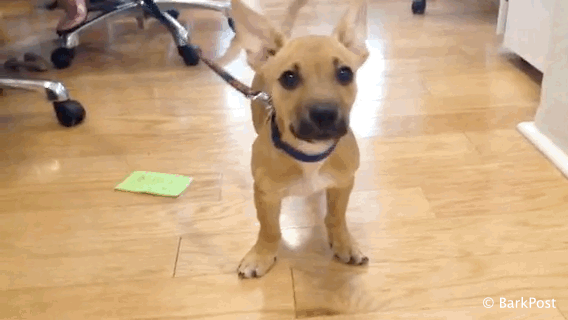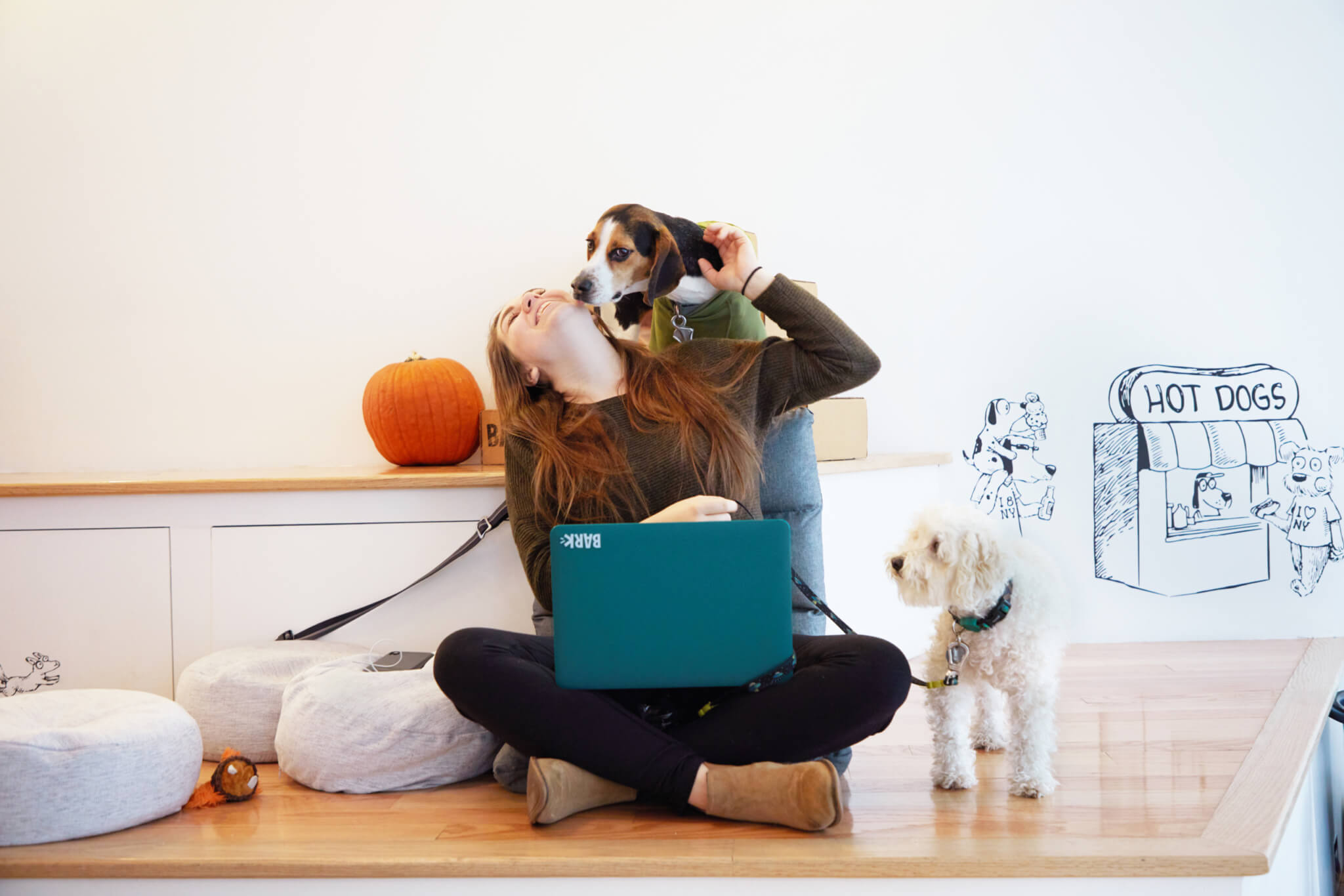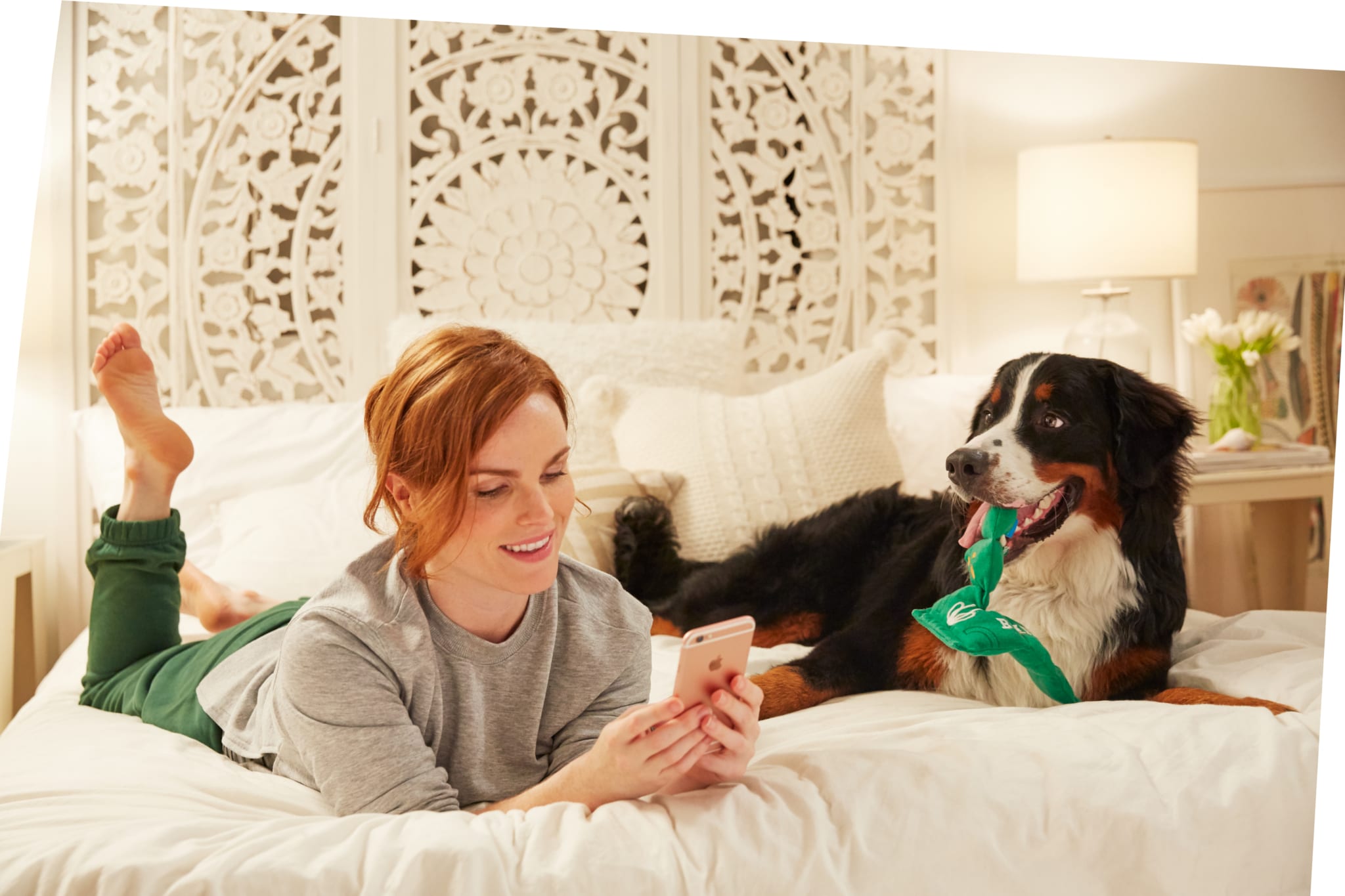You’ve made the big decision (which delights your dog-loving employees), and your office is going to welcome four-legged co-workers into their ranks! Or perhaps you’ve always been dog-friendly, and you’re easing back into office life after a year and a half of being remote-first. Either way, dogs (and humans) are going back to the office, which comes with new opportunities and challenges for employers, employees, and dogs.
BARK conducted a survey of American dog parents to explore the challenges of returning to the office, and found that many are looking and hoping for dog-friendly offices to ease the transition back. The survey found that 71% of dog parents who are still working from home believe they will miss their dog when they return to the office – this is significantly more than those who said they will miss their spouse (42%) or even children (39%). About one in three dog parents said they relied on their dog over the last year to keep them company and for emotional support more than they ever have before. While your dog’s intelligence may limit him from being able to balance the spreadsheet, we understand the desire to keep your companion at your side.


At BARK, we’ve been dog-friendly since we launched in 2012 and are old hands at opening offices and spaces where rule number one is to make it as dog friendly as possible. With that said, here are ten tips to make it happen:
If you don’t own your space, check with your landlord about their pet policies.
Yes, this may seem like an obvious “duh” moment. However, always double check that the building is dog-friendly (and if possible, make sure the lease paperwork spells out permission explicitly). Furthermore, you may want to check their policies on size or breed, as well as local ordinances and/or laws around these aspects. While we at BARK welcome dogs of all shapes, sizes, and genetic makeup, that may not be the case in your building or town. Always check, because you never want to get on the bad side of your landlord, their insurance companies, or local laws.
Make sure all employees are on board.
If this is a change you’re making, you’re going to want to consider the fact that not all employees may welcome this with open arms. The reasons can range from allergies, to phobias, to worries about dogs causing distractions. Sometimes, management will also need convincing. Make sure to do your research (there are plenty of studies about the benefits of dog-friendly offices) and assuage fears about productivity by having a clear plan in place about policies and processes around dog-human interactions.


Get down on all fours and consider the space from a dog’s perspective.
Kidding, you don’t actually have to do that (though just crouching down and surveying your office from that POV may open a whole new world). However, it’s worth considering that dogs experience the world very differently from humans—one of the basics being that their line of sight is a good three feet (or more) lower than ours. In practical terms, this means pulling things up off the floor that normally you wouldn’t think twice about, like the path of electrical cords, or making sure all trash cans are a certain height and have lids. Less obvious realizations are why the UPS man rolling an enormous cart of packages is way scarier when your eye level is one or two feet off the ground as opposed to five or more. We often consider sightlines here, since many dogs are prone to barking at entrances or getting worked up in meetings because of something called “barrier frustration.”
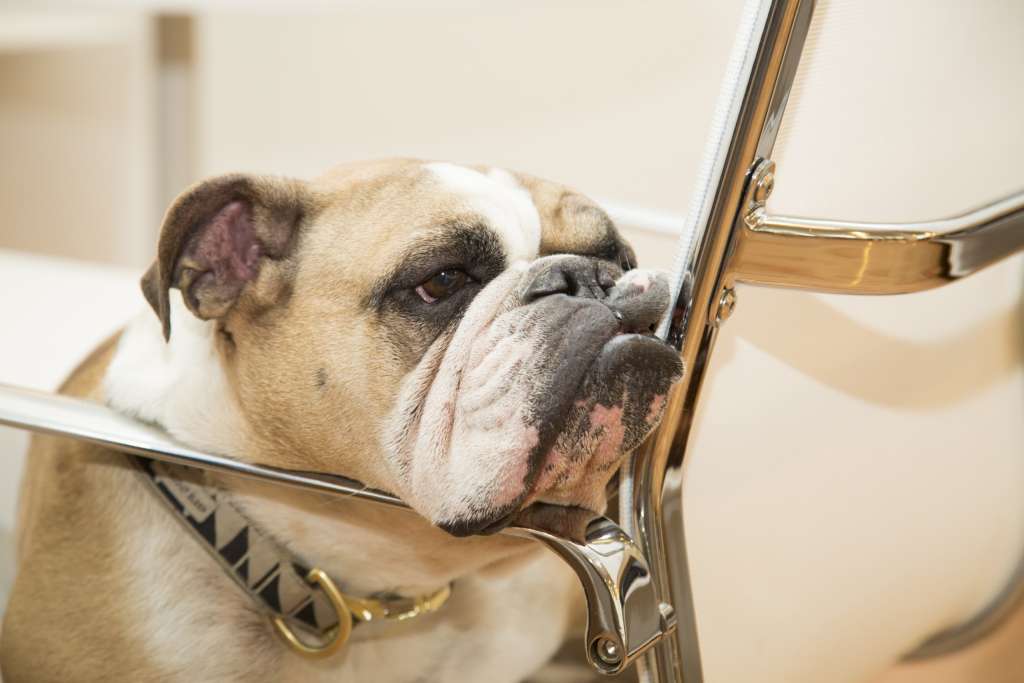

Do what Jason Bourne does—always know where your exits and entrances are.
Not only that, but secure them. Some dogs are more exploratory than others, and if you share a building with other tenants, always make sure a dog can’t easily escape through doors, windows, or stairwells to pay others a visit. This tip comes from experience; we used to share the building with a pharmacy, and our office manager would occasionally get a call from them about coming to pick up our employee’s three-legged chihuahua, who liked to wander down and eat the pharmacy’s plants. They were very nice about it, but it did make us re-evaluate possible escape routes we were overlooking because we weren’t five pounds and sneaky.
Consider consulting with a dog behaviorist or an experienced dog-friendly spaces expert as you draw up your plans and rules.
They have the know-how to point out common dog behaviors that may be problematic in an office setting (like territorial reactivity or resource guarding). They can also help you write clear ground rules with reasonable expectations from dogs and their people. For example, expecting all dogs to never bark in the office is, quite frankly, delusional. If that is a true expectation, you may want to make your office plant-friendly. Maybe fish-friendly. Dogs bark because, well, they’re dogs. However, expecting incessant barking or whining to be curbed and, better yet, providing tools for employees to help with these problems, is very reasonable.
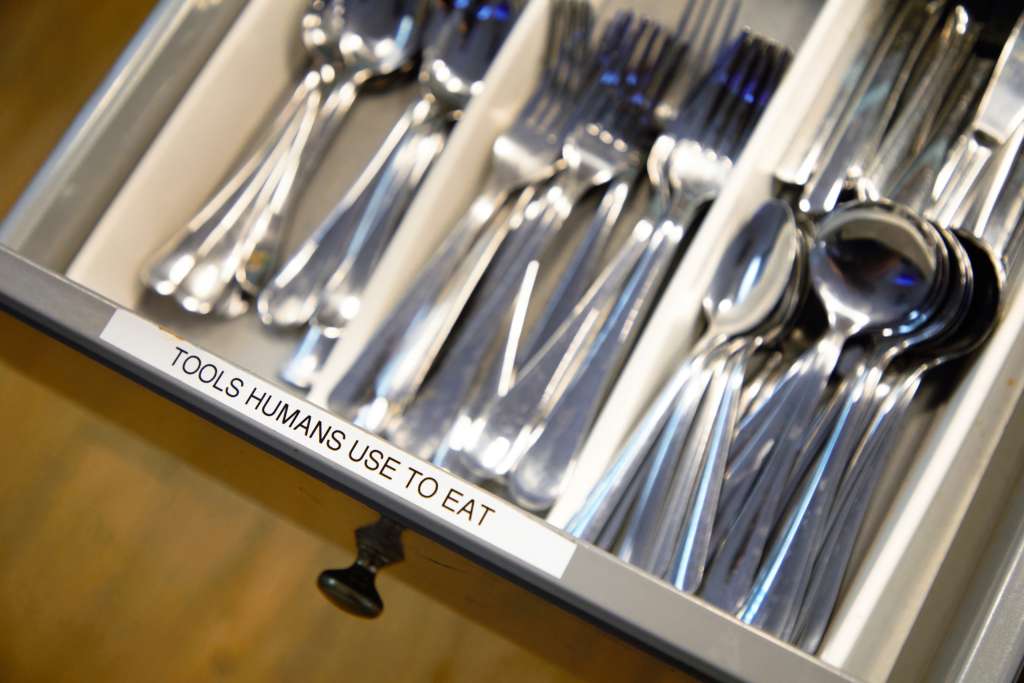

Lay down behavior ground rules from day one and make them clear to all employees and visitors.
Will dogs be off-leash or on-leash, and if the latter, will they be on-leash all day, or will you have a “free time” where they can wander around untethered? What are behavior no-nos (for pups and people) and how will you enforce them? Will you restrict the number of dogs coming in per day, or per human? Is there an age limit, will you allow puppies? When problems occur, who is the point person, and how will they help resolve issues? Can people bring supplies from their home to make the dogs more comfortable, or will the office provide? Finally, what (if any) are no-tolerance policies? Also make sure you check your company’s own insurance policies regarding dogs and any reasons you might need liability coverage. These are all things you have to think about and should have clear perspectives on, and then disseminate to all employees regularly so no one is taken by surprise when you ask them to, say, keep their dog at home for a week because they’re constantly barking.
One thing I’ve found very helpful is if there are any consequences to breaking a rule or policy, we always approach it as the first step to work toward a solution that benefits both parties, canine and human. Take the example above re: barking. For us, asking the human to keep the dog at home for a week isn’t a punishment. Instead, it gives us time to work with the employee and truly investigate why the dog is behaving in that manner. Sometimes, it’s a very simple solution. The dog may always be barking because the human sits right next to the entrance to the floor. This is a very common, very understandable reaction from a dog—many will “stranger danger” alert bark because over the thousands of years we’ve had canine companionship, we’ve genetically programmed this trait to aid in survival. The solution? We simply move the employee’s desk away from the door or restrict the dog’s line of sight so they can no longer see people entering and exiting, and voilà, the constant barking stops.
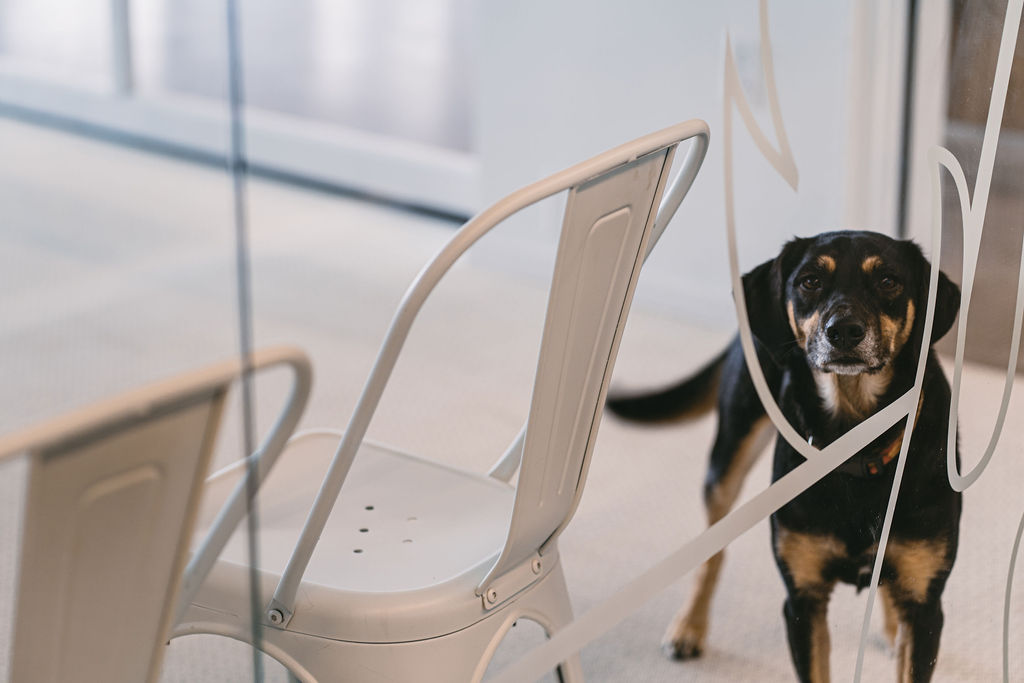

Supplies and information—have them on hand and easily accessible.
Cleaning supplies are a biggie (because it’s common for even house-trained dogs to have accidents in brand new environments). Make sure dogs have access to fresh water. Perhaps provide toys, comfortable beds, or crates. Also, make sure all dog-accessible food is safe. For example, everyone knows chocolate is a no-no, but did you know grapes and raisins are actually extremely toxic to dogs?
Accessible information is something you should have on hand. Do you have a dog trainer you can consult or offer to employees that want to work on a specific behavior? Do you offer pet insurance as a benefit (and if so, how does the employee enroll)? Most importantly, make sure you know the number and address of local veterinarians and emergency pet clinics. The last thing you want to be doing is googling “vets near me” when a dog may be in a serious medical situation.


Make sure there are ways for dogs to be dogs—e.g. encourage the “walking meeting.”
Dogs are dogs, and a dog-friendly office is generally overstimulating for even the most well-behaved pup. Plus, it’s an environment where the ground-rules and occupants may seem to them to always be changing. New people come in and out, new dogs come in and out, maybe you have rotating desks, so there’s never a space where the dog can consistently expect to hang out. Even people get bored stuck in hour-long meetings—imagine how the dogs might feel. Ways we’ve provided dogs outlets are: building a fenced-in play area on our second floor where they can go and burn off steam off-leash; providing chews and thinker toys to keep dogs occupied and quiet in meetings; offering beds and crates to employees to create safe spaces for dogs to retreat to when the environment is overwhelming; and encouraging walking meetings to do all kinds of business. Dogs will need to go on walks, if only to relieve themselves. Why not combine that with grabbing a coffee and having a one-on-one with a teammate?
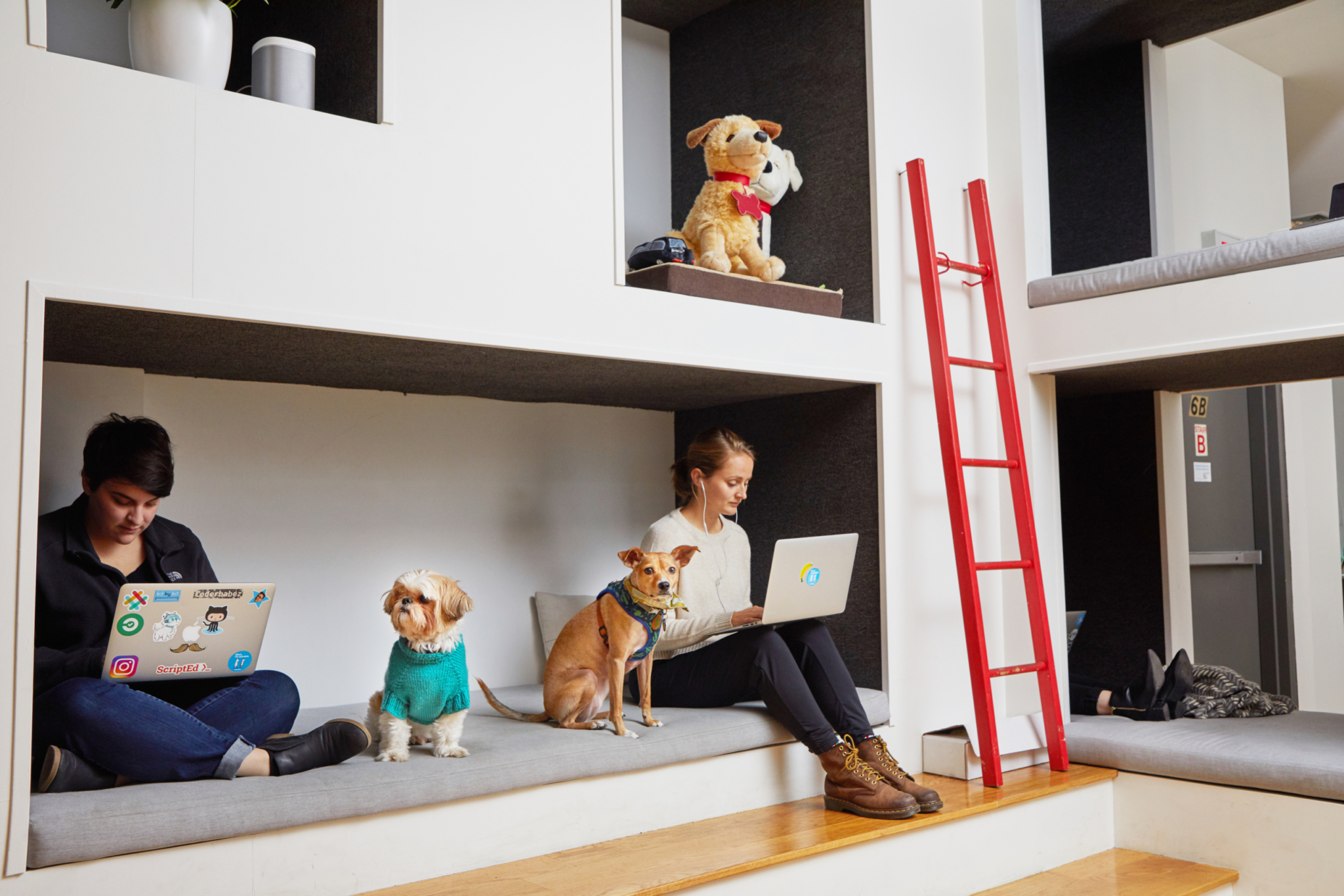

Give all employees (present or new) a quick tutorial on dog behavior.
A trainer or dog-space expert can create a little Dog Behavior 101 course to give to all employees. This can be a video, a slideshow, or even an in-person training. Perhaps some employees haven’t had the opportunity to interact with dogs in their lives; having them understand the basics of dog behavior will help pave the way for safe interactions and create a happier workplace.


Have fun!
Dogs are great because they live in the moment and never forget to enjoy life to the fullest. Having a dog-friendly office should create less stress for your employees, not more. Trust us when we say that when you’ve been knee-deep in spreadsheets for three hours, there’s nothing better than taking a break and playing with a pup to help put you in a better frame of mind. They also remind us not to take things too seriously and constantly make us laugh. How can you not chuckle when you realize a tiny dachshund has outwitted twenty humans, snuck into a conference room, and eaten the sandwiches meant for a meeting with Facebook reps? Ok, maybe it’s not funny at the time, but it sure as heck makes a great story and fosters an office culture that embodies resilience—sometimes things happen, and all you can do is laugh and move on.
